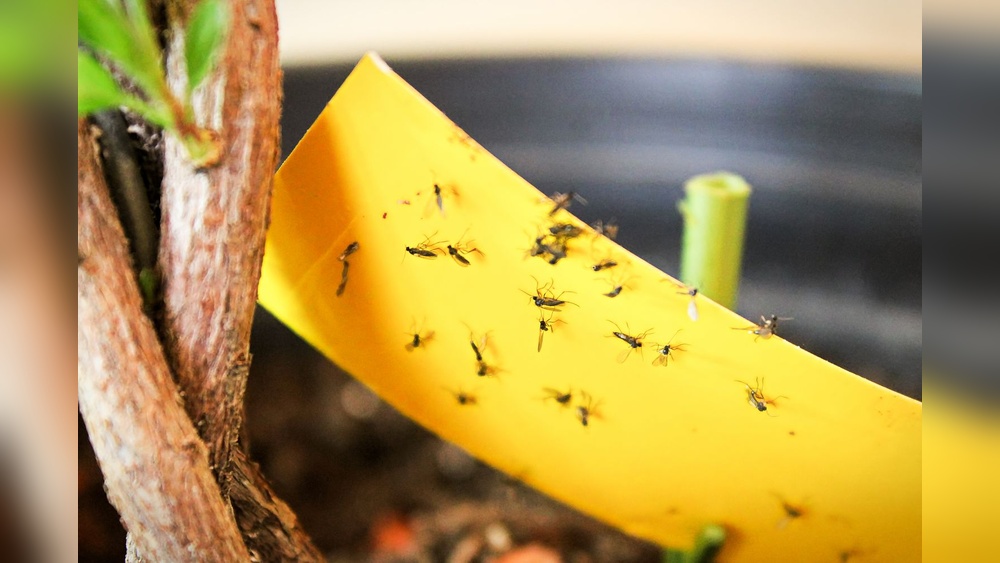Are you tired of seeing those tiny gnats buzzing around your kitchen, especially near the sink? You’re not alone.
Gnats might seem harmless at first, but they can quickly become a frustrating nuisance, contaminating your food and making your kitchen feel less clean. The good news is, you don’t have to live with them. By understanding where gnats come from and what attracts them, you can take simple, effective steps to get rid of them for good.
Keep reading, and you’ll learn easy ways to reclaim your kitchen and enjoy a gnat-free space.
:max_bytes(150000):strip_icc()/how-to-get-rid-of-gnats-in-your-home-5207918_final-41fa648920424fe9a9177585aef3d3fc.png)
Sources Of Gnats In Kitchen
Food residue in drains provides a perfect place for gnats to breed. Tiny bits of food and grease stick inside kitchen sink drains. This makes the area moist and inviting for gnats. Cleaning drains often helps stop their growth.
Unsealed fruits and vegetables left on counters attract gnats quickly. They feed on the sweet smell and lay eggs near the food. Covering or storing produce in sealed containers can reduce this problem.
Standing water and moisture around the kitchen, such as in plant pots or under sinks, creates a damp spot for gnats. Water that does not dry up fast becomes a breeding ground.
Leaky pipes and plumbing issues cause water to drip or pool in hidden spots. This constant moisture invites gnats to stay and multiply. Fixing leaks helps keep the kitchen dry and less friendly to gnats.

Cleaning Drains And Garbage Disposal
To clean drains and garbage disposal, start with baking soda and vinegar. Pour half a cup of baking soda into the drain, followed by half a cup of vinegar. Let it fizz for 15 minutes to break down grime. Rinse with hot water to flush out loosened debris.
The boiling water and dish soap method works well too. Mix hot water with a few drops of dish soap. Pour slowly down the drain to dissolve grease and kill gnats. Repeat this process twice a week for best results.
| Method | Description | Benefits |
|---|---|---|
| Baking Soda & Vinegar | Fizzes to clean and deodorize drains | Natural, easy, and affordable |
| Boiling Water & Dish Soap | Melts grease and flushes out debris | Quick and safe for pipes |
| Specialized Drain Cleaners | Chemicals designed to kill gnats and clear clogs | Effective for tough infestations |
Specialized drain cleaners can help if gnats persist. Use them carefully and follow label instructions. These products kill larvae and remove buildup inside pipes.
Managing Food And Trash
Washing fruits and vegetables right after shopping helps stop gnats. Leaving produce out makes it easy for them to lay eggs.
Dirty dishes in the sink attract gnats quickly. Wash dishes soon after eating to keep the sink clean and dry.
Trash cans can be a big problem. Empty trash often and clean the can with soap and water. Use a lid to keep gnats out.
Keeping food sealed in containers and wiping kitchen surfaces also helps. Dry areas where water can collect. These small steps reduce gnat problems.
Controlling Moisture From Houseplants
Avoid overwatering houseplants to control moisture that attracts gnats. Excess water creates wet soil that gnats love for breeding. Let the soil dry out between waterings to reduce moisture.
Check soil drainage by ensuring pots have holes for water flow. Use well-draining soil to prevent water from sitting. Good drainage helps keep the soil dry enough to discourage gnats.
Remove any standing water in saucers under plants quickly. Avoid letting water stay there for long periods. Keeping soil and surroundings dry makes the environment less inviting for gnats.
Inspecting For Leaks And Damp Areas
Check under the sink pipes carefully for any wet spots or drips. Leaks create moisture that attracts gnats. Even small leaks can cause problems.
Fix all leaky faucets and pipes right away. Tighten loose parts and replace worn washers. This stops water from pooling and removes gnat breeding areas.
Dry the area well after repairs. Use a cloth to wipe away water. Keep the space under the sink dry and clean to prevent gnats from coming back.
Diy Gnat Traps And Tests
The duct tape trap method works well to catch flying gnats. Take a piece of duct tape and fold it so the sticky side is out on both sides. Place it near the gnat problem areas. Gnats will get stuck on the tape as they fly near it. Check and replace the tape regularly to keep it effective.
Fruit vinegar traps attract gnats quickly. Pour apple cider vinegar into a small bowl or jar. Add a few drops of dish soap to break the surface tension. Cover the jar with plastic wrap and poke small holes in it. Gnats enter for the smell but cannot escape. This trap helps reduce gnat numbers fast.
Preventing Future Infestations
A clean kitchen stops gnats from coming back. Wipe all surfaces daily. Clean crumbs and spills right away. Empty trash often to avoid smells that attract gnats.
Store food in sealed containers. Keep fruits in the fridge or covered bowls. Avoid leaving food out for long periods. This limits gnats’ food sources.
Keep kitchen surfaces dry and clean. Fix any leaks under sinks. Dry sinks and counters after use. Gnats love wet places to breed.

Frequently Asked Questions
What Causes Gnats In The Kitchen Sink?
Gnats in the kitchen sink thrive on food residue and moisture in drains. Leaky pipes, unsealed fruit, and standing water also attract them.
Why Are Gnats So Bad In The Kitchen?
Gnats thrive in kitchens due to food residue, moisture in drains, unsealed fruit, and leaky pipes. These conditions create ideal breeding grounds.
What Is The Best Diy Gnat Killer?
The best DIY gnat killer uses a mix of apple cider vinegar, dish soap, and water in a trap. Clean drains regularly.
What Attracts Gnats To My Kitchen Sink?
Gnats like moist places with food bits, like drains, garbage, and fruit left out.
Conclusion
Gnats in the kitchen can be a real nuisance. Keeping your drains clean stops their breeding. Remove food scraps and avoid leaving fruit uncovered. Fix any leaks to reduce moisture that attracts gnats. Regularly empty trash and avoid standing water near plants.
Small steps lead to a gnat-free kitchen. Stay consistent with cleaning for best results. Your kitchen will feel fresh and pest-free soon.

